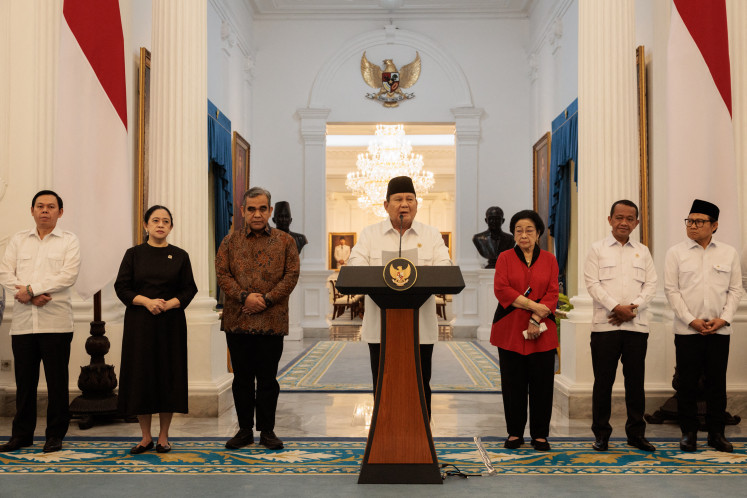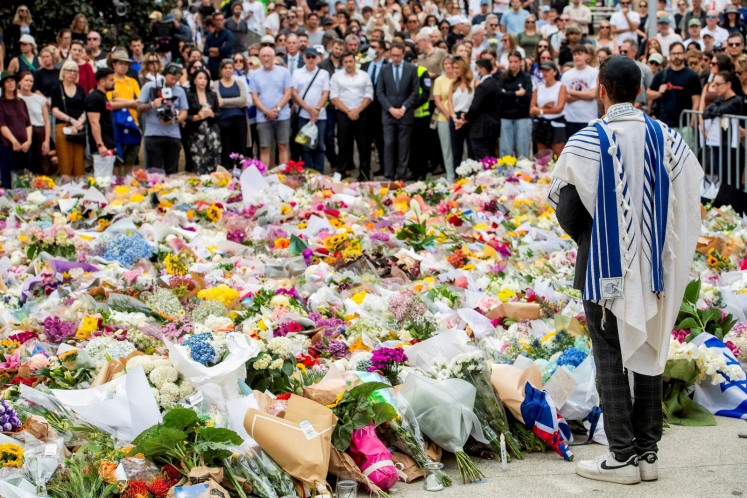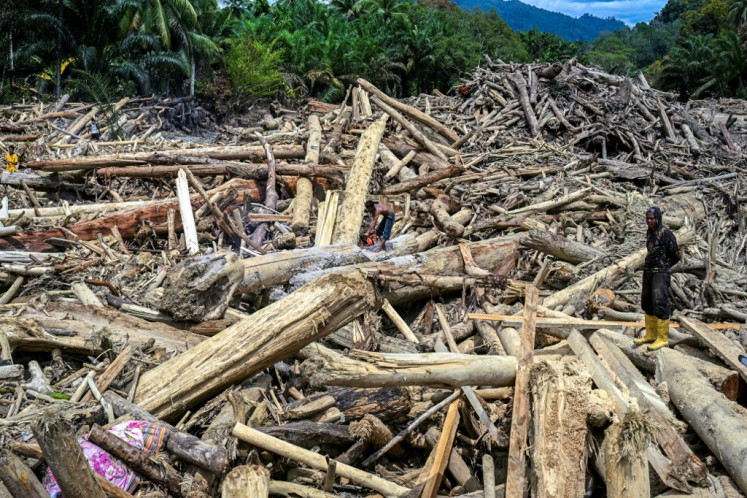Popular Reads
Top Results
Can't find what you're looking for?
View all search resultsPopular Reads
Top Results
Can't find what you're looking for?
View all search resultsCan social safety net ‘treat’ economic impacts of COVID-19?
Indonesia’s poverty rate could increase to 10.54 percent, or around 28.4 million people, without the intervention of the social safety net (SSN) programs. This would mean an additional 3.63 million poor people by the end of 2020.
Change text size
Gift Premium Articles
to Anyone
 Workers from Jakarta-owned food security company PT Food Station Tjipinang Jaya are seen packing staple food into red-and-white cloth bags with a printed message that reads: “Aid from the President of the Republic of Indonesia, Together We Fight COVID-19” at the firm's warehouse in East Jakarta on April 22.
(Antara/M Risyal Hidayat)
Workers from Jakarta-owned food security company PT Food Station Tjipinang Jaya are seen packing staple food into red-and-white cloth bags with a printed message that reads: “Aid from the President of the Republic of Indonesia, Together We Fight COVID-19” at the firm's warehouse in East Jakarta on April 22.
(Antara/M Risyal Hidayat)
T
he COVID-19 outbreak is threatening Indonesia’s achievements in reducing poverty to a single digit last year. In just two months, confirmed cases of COVID-19 infection have risen to more than 12,000 people. Formal and informal sectors have both been adversely affected, and those who cannot adjust to social distancing have been hit hard by the public health crisis.
In coping with the impacts of the epidemic, the government has issued fiscal stimulus packages by expanding social assistance and increasing benefits:
- Program Keluarga Harapan (PKH) conditional cash transfer for 10 million households, or around 20 percent of the poorest. The amount of cash assistance has been increased by 25 percent and is to be distributed monthly for a period of 9 months;
- Program Sembako non-cash food assistance for 20 million beneficiary households, expanded from 15.2 million beneficiaries to cover 30 percent of the poorest, with the amount per household increased to Rp 200,000 from Rp 150,000 per month;
- Social cash assistance for 9 million households outside Jakarta and urban areas, or around 30 to 40 percent of the poorest who are not beneficiaries of either the PKH or Program Sembako, with monthly assistance of Rp 600,000 for 3 months to be distributed by the national postal service;
- Bantuan Presiden (Presidential assistance) providing food aid to 1.9 million affected households in Jakarta and urban areas that targets micro businesses, seasonal creative workers and other informal workers who are not PKH or Program Sembako beneficiaries;
- National Health Insurance (BPJS Kesehatan), with coverage expanded to 107 million low-income households;
- Free electricity or a 50 percent electricity rate for low-income households; and
- BLT Dana Desa (Village Funds Unconditional Cash Transfer) for 10-12 million households not in the Data Terpadu Kesejahteraan Sosial (DTKS) integrated social welfare database, upon verification by local administration.
Fortunately, the government has improved its poverty data and has developed two enhanced mechanisms for distributing social assistance: One is the DTKS, which contains data on the bottom 40 percent of the poorest Indonesians; the other is the digital social assistance system, which was developed as Program Sembako in 2019. With these two instruments, we expect to maintain the poverty rate at a single digit to the end of this year, with several preconditions.
The Manpower Ministry estimates that 2-3 million people have been laid off amid the economic downturn due to COVID-19. According to a 2002 study in the American Economic Review, laid-off breadwinners reduced household spending by an average 15 percent.
Based on those assumptions, Indonesia’s poverty rate could increase to 10.54 percent, or around 28.4 million people, without the intervention of the social safety net (SSN) programs. This would mean an additional 3.63 million poor people by the end of 2020.
On the other hand, the expanded SSN programs could maintain a poverty rate as low as 9.24 percent, or 24.9 million people, only a slight increase from the September 2019 baseline of 9.22 percent. This means that the SSN could potentially keep 3.5 million people from falling into poverty.
Note that this mathematical estimate can only be realized under the strict precondition of accurate beneficiary data.
The Social Affairs Ministry refers to the DTKS for determining the targets of all SSN programs. However, the quality of the data relies on local administrations to regularly update their data as part of their responsibilities. Currently, only 50 regencies and municipalities actively update their data.
The COVID-19 epidemic offers the right time for local administrations to evaluate and update their data on the poor in their regions. A community-based identification and updating system is one of the best options.
Coherence and coordination between the programs is another precondition. Digitalizing social assistance has enabled more effective integration of SSN programs. The abovementioned programs can cover more than 40 percent of the poorest, if they are implemented in an integrated manner through a layered targeting system. This will work only if the targets of each program do not overlap, for instance between the programs of the social affairs and the village development ministries, not to mention local initiatives.
Meanwhile, regional officials have been directed to use the Village Information System to identify the correct beneficiaries for each social assistance program. The process of updating the data at the village level must include cross-checking the national identity numbers (NIK). Millions of data in the DTKS are still incomplete or inaccurate as regards the beneficiaries’ names and NIK.
***
The authors are officials at the Ministry of National Development Planning/BAPPENAS. The views expressed are their own.









